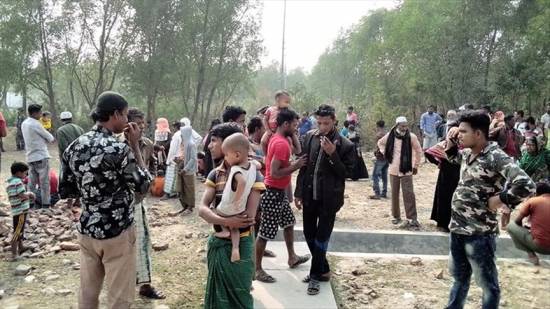Rohingya relocation: Bangladesh moves 4th group Featured
Amid constant opposition and concerns by international communities and rights defenders on safety grounds, Bangladesh on Saturday relocated the fourth batch of Rohingya refugees to a remote island in its southern sea, according to official sources.
A total of 1,463 members of the persecuted community began the journey to the Bhasan Char island from the country’s main port city Chattogram by naval ships.
“All concrete houses are fully prepared to house the new arrivals. Actually, we are ready to resettle all 100,000 Rohingya at the cluster houses on the island as per the government’s initiatives,” Commodore Abdullah Al Mamun Chowdhury, director of the Rohingya resettlement project, told Anadolu Agency.
With the new batch, the total number of Rohingya on the remote island stands at around 7,000 -- including 5,224 from previous three batches and 306 stranded Rohingya who shifted to the island nearly eight months ago after being rescued in the sea by the Bangladesh Navy.
Spending over $350 million, the Bangladeshi government has constructed 1,400 big cluster houses four feet above the ground with concrete blocks, along with 120 multi-story cyclone shelters on the island to relocate 100,000 Rohingya from the main camps in the southern district of Cox’s Bazar.
Bangladeshi authorities have defended the move as essential to ensure better living conditions for the persecuted people in a separate location and improve the packed camps in Cox’s Bazar.
The world’s biggest refugee settlements in Bangladesh’s main tourist hub Cox’s Bazar are currently housing more than 1.1 million Rohingya, most of whom fled the August 2017 military crackdown in Myanmar’s Rakhine state.
In the guise of curbing militants, the Myanmar army launched a brutal crackdown on Rohingya civilians in Rakhine, which has been called a textbook example of ethnic cleansing by the UN and a genocide case at the top UN court is still under trial.
“We are hopeful that the relocation of 100,000 Rohingya to the island will be completed within a short time as they [Rohingya] are responding to the move spontaneously,” Bangladesh’s refugee commissioner Shah Rezwan Hayat told Anadolu Agency.
Meanwhile, Chowdhury said the education program committed by the government for Rohingya children on the island has started with the help of some local NGOs.
“Currently 150 Rohingya children are being educated at the island’s education centers,” he said, adding that all 120 cyclone shelters are supposed to be used as learning centers or schools throughout the whole year, except the days of natural disasters, in accordance with the project planning.
International communities including the UN, however, have been opposing the move since the very beginning and demanding the relocation process to be halted until a full-fledged feasibility study is done over the habitability and safety of the island.
The silty island in the Bay of Bengal -- located around 50 kilometers (31 miles) off Bangladesh’s southwestern coast and nearly 193 km (120 mi) south of the capital Dhaka -- came into existence only two decades ago and is reportedly prone to natural disasters.
Before the construction of Rohingya resettlements, there was no human habitation on the island, popularly known as a floating island./aa


